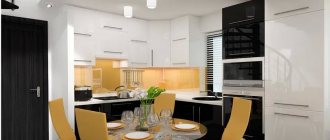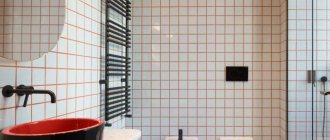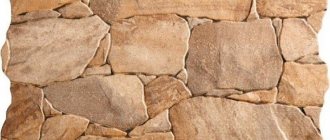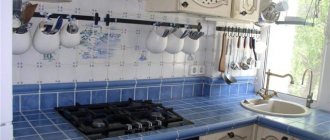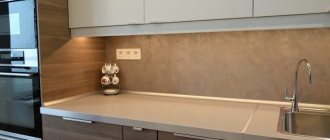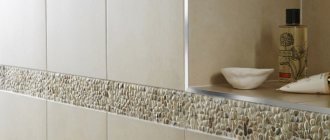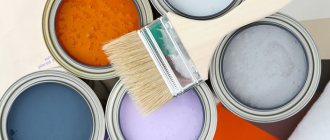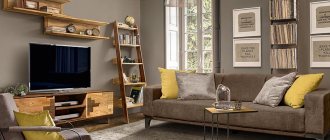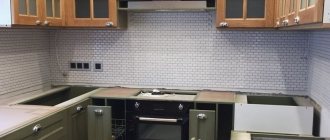Where to start choosing ceramics? First, study the assortment in the showrooms, listen to the opinions of experts about the manufacturers and determine the style of the future interior. In our article we will look at photographs of completed renovations in which tiles were used to create a kitchen backsplash.
The apron is the epicenter of shades in the room. The furniture, background color of the walls, floor and ceiling are designed in natural tones. Salons often present ready-made versions of decorative panels, and an individual approach to creating a design (made to order) is also possible.
Bright tiles on the kitchen backsplash
Main selection criteria
1. Glossy surface.
Such ceramics are easier to care for; the material reflects light, visually adding volume to the room. However, stains and traces of detergent and water drops are visible on the gloss.
White tiles with flowers on the backsplash
2. Lack of relief.
Despite the visual appeal of relief decor, it should be remembered that it is more difficult to remove dirt from the surface of volumetric ceramics.
3. Protective layer.
The transparent coating protects the material from the penetration of chemical compounds during cleaning. Packaging marked A or AA is what you need.
4. Buy products from the same batch.
To avoid discrepancies, pay attention to the batch number of each package. If the shade labeling is different, compare the products visually.
5. Dimensions.
Check the caliber of the slab batch. This parameter indicates the error of actual dimensions relative to the declared values (0-exact correspondence).
Selection principle: the size of the packages must be the same or differ by no more than one.
6. Quality of coverage.
The glaze layer must be solid - without cracks, chips or abrasions.
Follow the rules for storing ceramics. Products must be stored in a dry room, since the clay surface cannot get wet. If you use damp material, cracks will appear on the apron after cladding.
Photo
For inspiration, look at photo examples of popular masonry in real interiors:
How do you like the article?
Laying methods
Depending on the type of layout, the perception of the tiles in the apron area changes. Sometimes fragments of different sizes are combined on one wall, embodying the design idea.
Standard
The “seam-to-seam” installation technique is the optimal installation method that ensures minimal material consumption. The position of elements in adjacent rows is the same.
Decor on the kitchen apron
Tip: Considering the size, select the tiles in such a way as to avoid undercuts.
Diagonal
A universal method for any shape.
Stone surface tiles
A combination of straight and diagonal layouts.
Diagonal and straight layout in a country style kitchen.
Classic U-shaped kitchen
With offset
Installation “staggered” is quite simple: we move each fragment of a new row by half of the body.
Apron with bright decor in the kitchen
Vertical version of the cladding “staggered”. The disadvantage of laying is trimming some of the parts that complete the row.
Gray tile backsplash in the kitchen
Herringbone
The tiles fit together at right angles. This scheme looks unusual even in a monochromatic version. Light grout emphasizes the direction of the masonry.
Black glossy apron
Chess
Beige-brown apron in a corner kitchen with an island
For checkerboard cladding, it is not necessary to use fragments of different colors; tiles with the same pattern, which are rotated 90 degrees, are also suitable.
Checkerboard tile layout
Lines
The chamfered elements are laid using the traditional “seam to seam” method. The alternation of colors adds variety to the apron area. Subdued tones are combined with the interior palette.
Black and white tiles on the backsplash
Ceramic strips are in harmony with the facades and the tone of the walls.
Orange-gray tiles
Kaleidoscope
In this layout you can use two or more shades.
White and yellow tiles in the kitchen splashback area
What material should I use for flooring?
Ceramic tiles are the best option for a checkerboard floor; they are easy to lay during installation and easy to maintain in the future.
The best option for kitchen flooring would be ceramic tiles or porcelain stoneware surfaces. The first has smooth shapes, which will ensure the correct combination of colors when creating a contrasting pattern.
It is very practical, reliable and durable. It is easy to clean and is not damaged by water. You can lay PVC tiles. It is less expensive than a ceramic slab and comes in the form of durable linoleum, which is designed in the form of individual squares.
Such a surface must be laid on a leveled floor base. Sometimes laminate is used to create a contrasting pattern. However, it is not practical enough to be used as a kitchen covering.
Tile sizes
Consider the size of the set when choosing tiles. The height of the cladding is most often 500-600 mm, but it is better to continue the finishing a couple of centimeters (put it under the upper tier of cabinets).
Do not forget to include in the calculation the section of the wall behind the hood (between the upper modules).
Other options for finishing the apron in a special material.
10x10 cm
The main advantage of the format is the minimum of trimming during the surface finishing process.
Black tiles with panels
The size of 10x10 cm visually enlarges a small kitchen area. Such elements look harmonious in combination with a compact set.
Polish collection Inwencija – 100x100 mm. Manufacturer: Opoczno. A combination of two series – “Lemonka” and “Bez”.
Square tiles on backsplash
The small shape allows you to decorate hard-to-reach surfaces. This format is convenient to combine with decorative panels.
Please note that installation of 10x10 cm ceramics requires certain skills. The seam between the tiles will be larger than when joining large tiles.
Some manufacturers produce an imitation of such tiles, combining several elements in one (200x200, 200x300, 300x300, 300x400 mm). In this case, the cladding time is reduced. The process becomes less labor-intensive (available not only to professional builders).
Kabanchik
This ceramic resembles brickwork. “Boar” is suitable for interior decoration in neoclassical, modern or classic style.
White brick tiles in the kitchen
Size range: 65x120, 75x150, 85x285, 100x200, 100x250, 150x450 mm.
The most common options for repair are 75x150 and 100x200 mm.
White “hog” is chosen more often than other shades. Mostly the tiles are plain and glossy. The color can be rich, but not flashy. There are also collections with photo printing. Often, decorative elements depict berries, grass, flowers, fruits and other symbols that complement the culinary theme.
Corner kitchen with gas boiler
If you are renovating yourself, opt for a large format that combines several bricks on one element. Facing with such material is accessible even to beginners.
Mosaic
It is better to entrust the installation of classic mosaics to specialists so that the surface turns out to be spectacular, with neat seams. For cladding with your own hands, purchase ceramics for mosaics or fixed on a mesh.
Classic kitchen with mosaic backsplash
The design of the mosaic can be different: square, rectangular, round, futuristic shapes, in the form of a polygon, fragments or natural stones.
Green ceramics in the kitchen with black and white facades
Medium format
The main background is light tiles. When choosing a large format for finishing, you should not overload the surface with color. Interesting details in this version are decorative inserts and pastel stripes. The color of the grout unifies the ceramic sheet.
Pastel tile collection
The white apron is diluted with green mosaic lines.
White and green apron in the kitchen
Large and medium-sized elements are not suitable for a miniature kitchen. Such decoration will only increase the feeling of crampedness in the room.
Manufacturers
Modern versions of kabanchik (subway) tiles are usually sold in trade organizations under their own names, which were named by the manufacturers. There are a lot of options on sale with different sizes and shapes of surface relief. The main feature remains only the aspect ratio - 1:2, which allows you to create the correct cladding patterns.
Among the most popular manufacturers from the budget sector are:
- Cersanit. A Polish enterprise that launched production in Russia in 2010. The assortment includes different types of tiles, including boar-type models, monochrome or with various thematic “kitchen” patterns;
- Estima. Russian enterprise established in 2001. The boar model is only a very small part of the total production volume;
- Jade Pottery . Another Russian manufacturer producing high-quality products on Spanish and Italian production lines. About 10% of the entire range of retail chains is supplied by this manufacturer. The quality of the tiles is practically not inferior to European standards.
Manufacturers supplying material at an average price level:
- Vitra. Turkish company operating since 1991. We produce high-quality products that are known in all countries of the world. The assortment also includes boar tile models;
- Creto. Russian manufacturer of ceramic tiles. There are two lines of hog tiles, with imitation of natural materials (wood and stone);
- Kerama Marazzi . A joint Russian-Italian enterprise operating since 1988 on the initiative of the Italian side. Today there are three factories in Russia that produce a wide range of different types of cladding. There are several lines of boar tiles, although only one series has a standard aspect ratio.
Companies whose products can be classified as top-notch:
- Ragno. A manufacturer from Italy, whose products appeared on the market back in 1949. Among the boar-type tile models, we can highlight the WOODESSENCE line with a non-standard aspect ratio (width 100 mm, length 700 mm). Cost 1m2 - from 3600 rubles;
- Italon. Italian company, part of the Atlas Concorde group. Since 2006, the Russian branch has been operating with production facilities in Stupino. A large volume of products is produced, including two model lines of hog tiles. The cost of 1m2 starts from 2580 rubles;
- Carmen. A Spanish company that is part of the APE CERAMICA production holding. The company's assortment, in addition to other products, includes 4 model lines of boar tiles. The cost of 1 m2 starts from 3,500 rubles, but the quality of the material is very high.
Only some manufacturers are listed. The assortment of specialized stores includes products from a huge number of domestic and foreign companies that have high quality and external characteristics. However, it is not advisable to select a material only by the name of the manufacturer. First of all, you should consider its parameters - aspect ratio, color, and other indicators.
Design options
Pastel colors
Minimalism in the kitchen: laconic facades without handles, glossy surfaces, wood texture, stone countertops, creamy beige interior colors.
Kitchen with wood-effect facades
Neoclassicism in monochrome shades.
Beige straight kitchen with neoclassical facades
Mint walls, stone floor texture and creamy furniture. Tall furniture does not look bulky due to the light shade.
Green apron in a white kitchen
LED lighting reveals the relief of ceramic bricks, revealing the volume of the masonry.
Green kitchen and white apron
Diagonal layout combined with decorative panels. The finish imitates aged stone. This combination suits the classic style.
Diagonal layout and ceramic panels in the kitchen
Rich colors
Blue accent in a black and white kitchen interior.
Blue apron in a white kitchen
Green mosaic in the kitchen
A terracotta tiled screen protects the walls from moisture in the washing area.
Terracotta tiles in the kitchen
Black accent against the background of a light interior.
Black tiles in a white kitchen
Bright collections
Fruit inserts harmonize with the background tone and bright stripes of tiles. Most manufacturers have similar collections. The decor can be dispersed along the entire length, or concentrated in one part.
Bright tiles on the backsplash
Sometimes the decor is chosen from another collection. The main thing is that the thickness of adjacent parts matches - in this case the surface will look uniform.
Lime apron in a white kitchen
Patchwork ornament should be used with caution. A mottled pattern can cause irritation if the cladding occupies a large area. In this interior, patchwork decorates the walls and the insert on the floor; other parts of the decoration and kitchen furniture are kept in simple colors. In such a room there is no feeling of fatigue from the abundance of color.
Patchwork in the kitchen with black stone countertop
Mixing different formats and colors. The complex design looks harmonious due to the use of two main shades.
Blue-green tiles in the kitchen
Mosaic backsplash with bright segments. The walls and floor support the tone of the mosaic.
Orange and yellow mosaic
Decorative inserts
As a rule, decor is more expensive than background material. Despite the cost, this solution definitely makes sense. Decorative details adorn the apron, diluting the monotonous color.
Beige apron with decor
Uneven contours, imitation of aged clay tiles or stone are suitable for a set in country and Provence style.
White solid wood kitchen and beige ceramic apron
Decor that illustrates nature. The sepia tone of the images follows the tone of the facades.
Marble countertop in the kitchen
Mosaic panels are suitable for any kitchen style. The most important thing is to choose the right pattern and color scheme.
Mosaic with mirror inserts
Decorative inserts with floral patterns are often found in classic collections of ceramics, Provence and country. The design is applied to one tile or to several elements (4-6 pieces).
Sunflowers on the apron
Common decor dimensions: 500x300, 600x400, 600x600, 800x600 mm. Photo tiles with abstraction, city landscapes and stylized culinary images are suitable for modern interiors.
Materials
Ceramic
Gray and white facades in the kitchen
Glass
Red glass apron
Mirror. Such material will visually increase the area, but the constant reflection of objects can create discomfort in everyday life.
Mirror mosaic in the kitchen
Metal. Metallized Ferrum Style series. Manufacturer: STS-Trading company. These tiles are used to cover floors, walls, facades, stairs, columns, building bases, and fireplaces.
Metal tiles in the kitchen
A little about versatility
Black and white kitchens are famous for their versatility. It is difficult to attribute such decor to a specific style, because it fits organically into almost any type of interior.
Let me give you examples:
- Classic style. For timeless classics, it is better to use a monochromatic set (either black or white). In this case, the ceiling and walls should also be left plain, abandoning any ornament;
With just two colors you can create a high-quality classic interior
- Modern. Glass or mirror surfaces on the cabinet fronts will help add sophisticated chic to the interior. Metal elements (accessories, dishes) will also come in handy;
It would be nice to choose the appropriate accessories for a white and black kitchen
- High-tech or minimalism. Such styles only benefit from contrasting solutions, which is why black and white minimalist kitchens have been in demand for many years.
Minimalism or hi-tech are especially popular now
Marking
Another important step (they all are). Using a level, we outline the upper and lower boundaries. We draw the left and right lines, as well as additional auxiliary vertical lines, along a plumb line. Along the lower border we install a barrier made of a bar or aluminum profile. It will support the tile until the glue sets and will prevent it from slipping. After completing the marking, we evaluate it again by eye from a distance. If any lines are in doubt, they need to be double-checked for level and plumb, and, if necessary, corrected.
How to make holes for sockets
A regular concrete drill with a pobedit tip will not be enough here. The most important thing: the holes must be made before laying the tiles on the wall. Firstly, it’s more convenient to work this way, and secondly, if the tile does crack, you can simply take a spare one instead of removing the damaged one from the wall. Special diamond-coated drill bits are sold for drilling tiles. You need to drill at low speeds and be sure to turn off the impact mode.
Bathroom color scheme
Bathroom color is an important design component. When choosing it, the first thing to consider is the area of the room. If it is small, then the decorative finishing should visually enlarge it.
This can be achieved by choosing the right shade of the walls.
The tones used should be close. Place them side by side on the color wheel. Yellow shades with orange, turquoise and green are perfect. Such combinations emphasize the advantages of the bathroom. The atmosphere of the room is pleasant and relaxing.
The marine theme is widely used in the bathroom. Its main colors are sand and different shades of blue.
The overall picture of the interior is reminiscent of the seashore, helping to forget about everyday work and relax. The color intensity is selected taking into account the wishes of the owners. It can be either calm or bright. The only drawback of such a project is the coldness of the interior. The room is not comfortable for hygiene procedures and spending time.
This must be taken into account when choosing a design.
Bright walls look good in the bathroom. Rich shades allow you to create a surge of emotions in a room. It will become a kind of island of positivity, where you can recharge yourself with energy and good mood. Orange and purple, red walls with green accents are perfect for this design.
You can dilute the rich colors with white tiles.
The main tile is not always chosen first. There are interesting installation solutions in which the decorative surface is first determined. As a rule, the main white tile is complemented by several other shades.
The mosaic looks original and modern. This type of tile is suitable for decorating small rooms. It can be combined with regular tiles. The main thing is to choose the right color.
Some dark shades will also allow you to expand the space. Rich gray will visually expand it. But the overall interior can be sad and gloomy. To prevent this, it is worth adding bright accents to it. Red elements, turquoise and yellow will cope with this task perfectly.
You can get a stylish bathroom design by using brown shades. They are diluted with white tiles. Soft, muted tones make the interior refined and noble.
